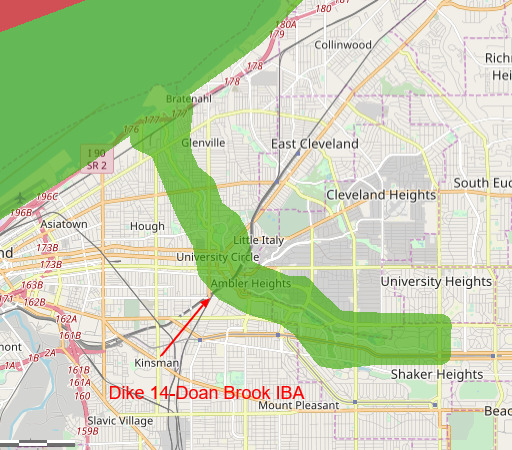Dike 14-Doan Brook Important Bird Area
Dike 14-Doan Brook
Important Bird Area
Explore in eBird
Entire Year – Spring – Summer – Fall – Winter
Locations
Cuyahoga
Cleveland Cultural Gardens
Rockefeller Lake
Shaker Lakes Park System
Shaker Lakes--Doan Brook Gorge
Shaker Lakes--Green Lake
Shaker Lakes--Horseshoe Lake
Shaker Lakes--Lower Shaker Lake
Shaker Lakes--Marshall Lake
Shaker Lakes--Nature Center
Shaker Lakes--Southerly Park
Wade Lagoon

About Dike 14-Doan Brook Important Bird Area
This IBA includes the riparian corridor of Doan Brook, an urban stream including the Shaker Lakes and The Nature Center at Shaker Lakes, and much publicly owned land along the corridor. The 88-acre Dike 14 impoundment lies at the mouth of Doan Brook where it empties into Lake Erie approximately four miles east of downtown Cleveland. Doan Brook is about 8.4 miles in length with a watershed of about 11.7 sq. miles.
Near the southern terminus are the Shaker Lakes, consisting of a number of parks along Doan Brook. Two of the lakes were created by the Shakers in the late 1800s to power their machinery. The Nature Center at Shaker Lakes preserves a variety of natural habitats including lake, stream, field, forest, marsh, and ravine.
Four miles east of downtown Cleveland, at the northern terminus is Dike 14, a retired confined disposal facility of the U.S. Army Corps of Engineers, which received dredge spoil from the Cuyahoga River channel in Cleveland. The habitat of Dike 14 has changed considerably since the confinement breakwall was completed in 1979. Early in its development, the mudflats generated in this dredge disposal impoundment on the Lake Erie shore were the site of numerous exceptional shorebird records, with 38 species noted during the 1980s, including Sharp-tailed and Curlew Sandpipers. Following filling to capacity, succession progressed into a primarily shrub/scrub stage and the lakefront habitat now offers patches of exposed mud, fragments of wetlands, early/late fields, early successional woodland, and coniferous stands. It remains an important stopover for migrant birds although the species composition has changed from a shorebird focus to a passerine focus. Surrounding waters, including a boat club, breakwaters, and hot water outlet at a nearby power plant to the west create the continual potential for a great variety of birds. It provides a unique site near to a major urban center. The area has produced confirmed sightings of Sharp-tailed Sandpiper, Ruff, Yellow Rail, King Rail, Le Conte’s Sparrow, and nearby Ivory gull, Black Guillemot, and other rarities.
Literature records go back to 1900 with many records from famous ornithologists.
The complete riparian corridor has a rich history- over 100 years of bird observation with over 70 years of bird walks by Cleveland-area Audubon groups. Thousands of warblers and hundreds of sparrows are possible on single days in spring and fall.
This IBA includes Dike 14, which hosts exceptional concentrations of migrant land birds, due to its location on the Lake Erie shore and the fact that it is an “island” of habitat surrounded by urban area. There have probably been over 300 species of birds sighted in the impoundment and surrounding areas (Lakeshore, yacht basin, power plant hot waters area to the west). Since 1979, observers from the Kirtland Bird Club and Audubon have recorded at least 278 species of birds at Dike 14. Local birder Sean Zadar personally observed 220 species over a two-year period, including such species as Least Bittern, Northern Goshawk, Long-eared Owl, Short,.eared Owl, Northern Saw-whet Owl, Upland Sandpiper, Olive-sided Flycatcher, Marsh Wren, Sedge Wren, Connecticut Warbler, Yellow-breasted Chat, Le Conte’s Sparrow, Nelson’s Sharp-tailed Sparrow, Henslow’s Sparrow, White-winged Crossbill and Evening Grosbeak. This site acts as a migrant trap and offers critical stopover habitat for a wide variety of migratory birds. During migrations, large numbers of sparrows exploit the resources provided by Dike 14. Short-eared Owls and Northern Saw-whet Owls frequent the area during their annual migrations, while Northern Shrikes are regular winter residents inside the impoundment.
Bird occurrences at Dike 14 extend beyond considerations of species to numbers of individuals. Dike 14 has consistently hosted 15 or more Orange-crowned Warblers in a single day during fall migration. Other examples are single-day records of 1,000 White-throated Sparrows, 600 White-crowned Sparrows, 500 Dark-eyed Juncos, 300 Golden-crowned Kinglets, 200 Ruby-crowned Kinglets, 60 Northern Flickers, 65 Palm Warblers, 46 Nashville Warblers, and 102 Magnolia Warblers. It also may be the optimal place in Ohio to find a fall migrant Le Conte’s Sparrow. The first Ohio records for Sharp-tailed Sandpiper (October 1984) and Black Guillemot (November 1990) are from Dike 14.